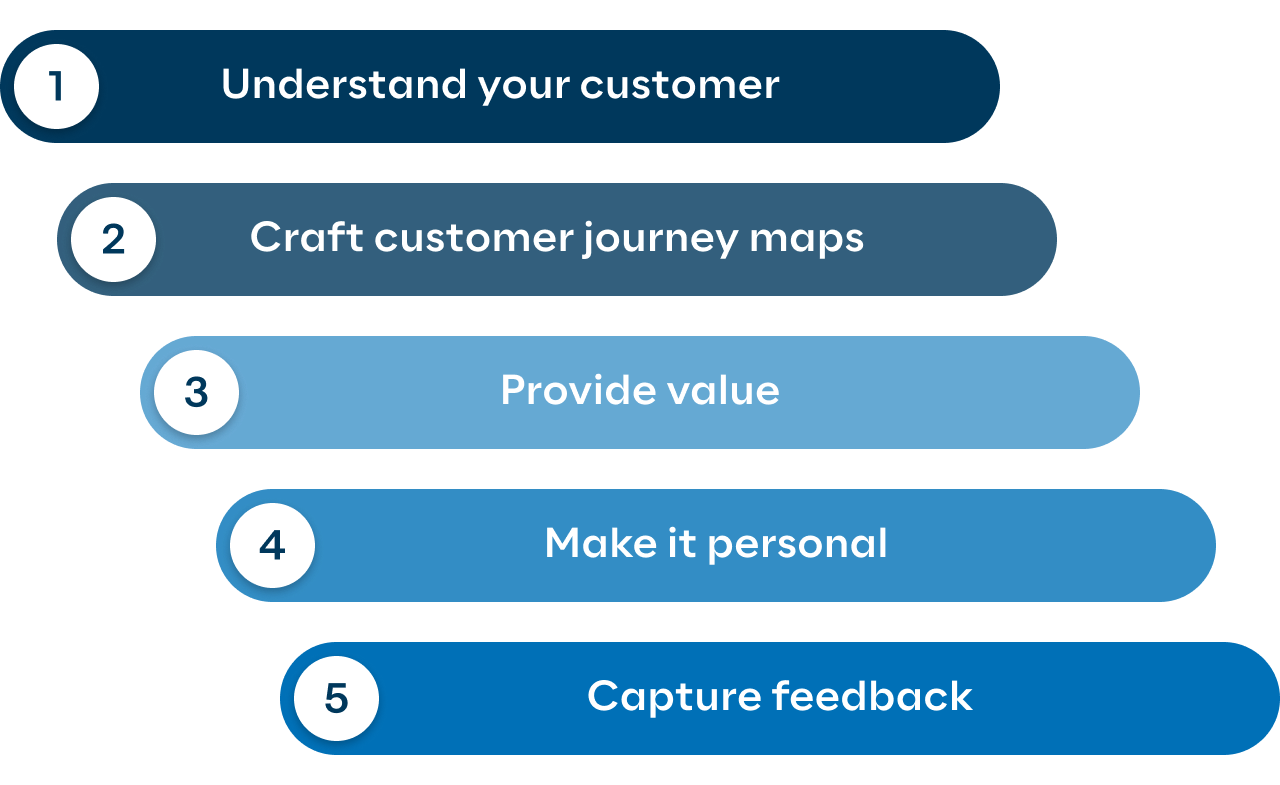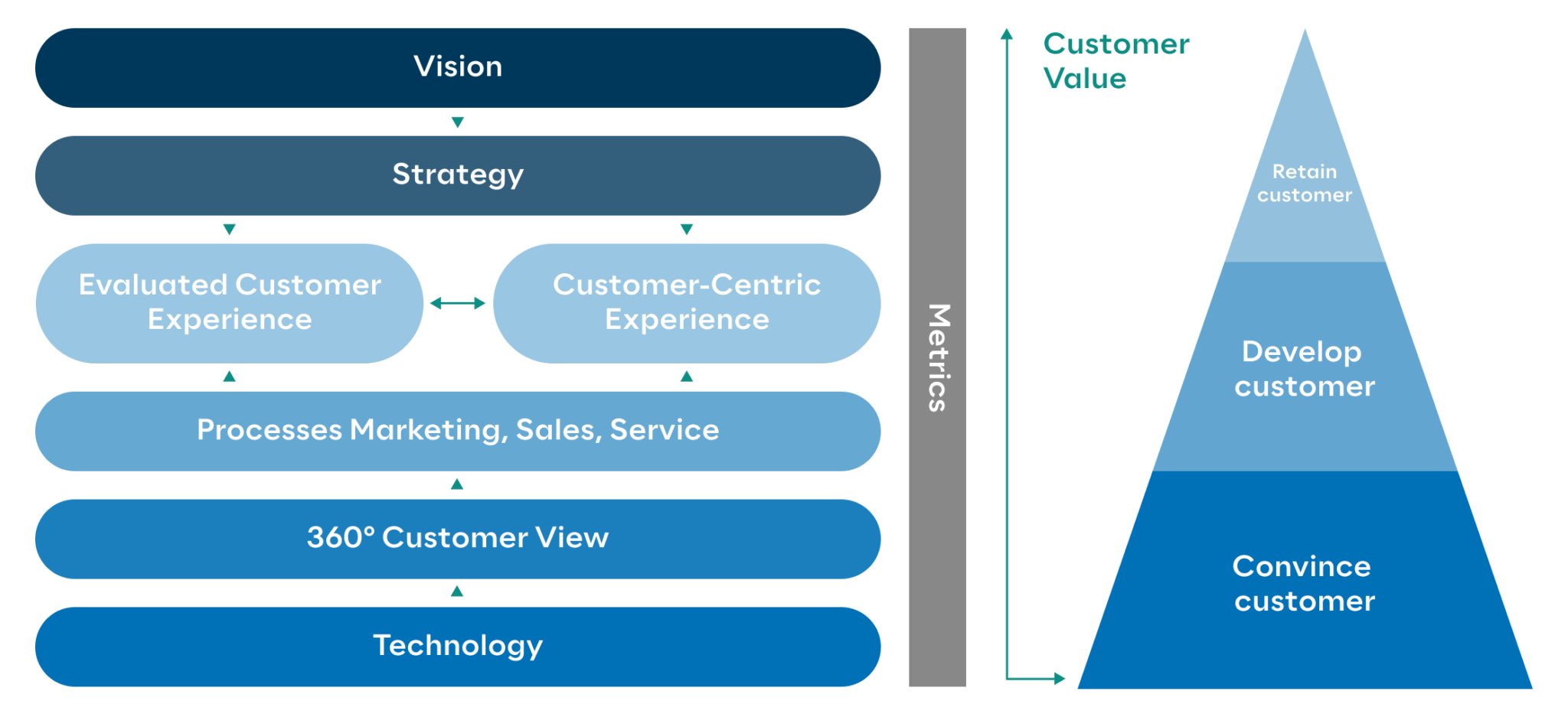Future customer communication will place the customer at the center of a personalized world of experience. Data is generated and interpreted along the entire life cycle of a customer and used for a targeted and personalized approach via customer-specific channels. They therefore help to recognize and develop new customers as well as customer loyalty through targeted further development. AI-based solution architectures provide the crucial technical basis for analyzing the data and targeting suitable communication measures.
Many companies ignore the fact that the technical side is only a tool and that the organizational anchoring of customer-centric strategies is the decisive basis for a future-based solution architecture and should be established beforehand. Customer Experience Management, or CXM for short, is the perfect approach for the necessary organizational changes.
CXM not only describes the manner of communication, but also represents a cross-organizational method of customer perception.
CXM is much more than that – let’s start with a few definitions:
“The practice of designing and responding to customer interactions to meet or exceed their expectations, resulting in greater customer satisfaction, loyalty and advocacy”.
– How Gartner defines customer experience management
According to Microsoft, Customer Experience Management, often referred to as CXM or CEM, is a system of marketing strategies and technologies that focus on customer loyalty, satisfaction and experience.
Many organizations have a CRM system in place. However, CXM goes further and is based on a deep and comprehensive understanding and alignment of the organization with customer needs.
The following is a comparison between CRM and Customer Experience:
| Customer Relationship Management | Customer Experience |
|---|---|
| CRM encompasses the practices, strategies and technologies that companies use to manage and analyze customer interactions and data throughout the customer lifecycle. | CX is the perception of a customer after engaging with a company, brand, product or service. |
| Improves customer service relationships, assists in customer retention and drives sales growth. | CX management is the collection of processes to track, oversee and organize every interaction between a customer and the company throughout the customer lifecycle. |
| Complies customer data across different channels, including company websites, telephone, live chat, direct mail, marketing materials and social media. | CX rapidly expands the vision of the optimized customer journey beyond conversion and sales and into all enterprise silos and channels |
| Gives customer-facing staff detailed information on customer’s personal information, purchase history, buying preferences and concerns. | Requires a 360-degree view of customers, with integrated, up-to-date data on customer accounts and data analytic tools to sell to customers in a more personalized fashion. |
| Consolidates customer information and documents into a single CRM database so business users can more easily access and manage it. | Four critical steps in a successful CX strategy include understanding customer needs, creating a customer vision, developing an emotional connection and capture customer feedback. |
| Additional functions include AI; analytics; geolocation; marketing, sales force, contact center and workflow management; and lead and HR management | Leading CRM/CX software vendors now lean heavily toward crafting a personalized customer experience. |
Instead of individual and selective measures, CXM deepens the understanding and interaction with customers. You should proceed as follows:

CXM is built around the philosophy that every service and offer should be designed with the customer at the centre. By integrating the Voice of the Customer (VoC) into all business processes, companies can align their operations to better meet customer expectations. The customer is in the centre of all strategies and processes.
The decisive basis here is the definition of a vision, i.e. a guiding principle for dealing with the customer and what added value the organization brings to the customer. A strategy can then be derived from this and a road map for the implementation of corresponding organizational measures can be drawn up. It is important to make the individual measures measurable and transparent, as this is the only way to ensure a successful change to a customer-centric organization.

It is important to take cross-company measures and establish agile and flexible cross-departmental collaboration. Introducing overarching processes for all departments with customer contact, which then access a shared data pool, is one of the most important success factors here. All customer information and contacts are centralized here and made available to all internal stakeholders involved. The aim here is to acquire new customers, convince them of the company’s own products or services and develop them into loyal and satisfied customers by increasing customer value.
Lay the foundations for an agile CXM organization: Marketing, Sales & Service work closely together here and jointly define standards for agile collaboration.
How do I establish this change in my organization?
Every change is individual and depends on many organizational factors that need to be weighed up in detail. We recommend the following approach:
- Create a CXM Vision: Develop a vision for CXM tailored to your organization, aligning it with strategic goals and customer expectations.
- Establish a Company-Wide Understanding: Communicate the CXM vision across all organizational levels and conduct training to build CXM capabilities.
- Develop Customer Journey Maps: Identify current customer journeys, pinpointing pain points
- Implement Voice of Customer Programs: Establish mechanisms for regular customer feedback collection
- Integrate Technology: Utilize CRM and other customer-centric technologies to gather data and personalize interactions, ensuring integrated systems.
- Foster a Customer-Centric Culture: Encourage employees to take ownership of the customer experience and reward behaviours that enhance customer satisfaction.
- Monitor and Adjust: Regularly assess the effectiveness of CXM initiatives, remaining flexible and ready to adapt based on feedback and evolving needs.
Make the change transparent and demonstrate the added value of such a paradigm shift for the parties involved.
Investing in customer experience management can give your organisation insight into how customers experience your brand, what’s missing and how to do it better.
The benefits include:
- A customer-centric company culture with a corresponding mission and values
- Better informed product development and service delivery based on customers’ actual expectations, thoughts, actions and behaviours
- Lower churn rates and more opportunities to upsell existing customers
- Better reviews and testimonials due to continuous, positive customer interactions
- A good ROI (Return on Investment), or ROX, Return on Experience
Are you ready for the future? If you also want to become a customer-centric company, don’t hesitate to contact us for further details.
Marketing Automation with Like Reply
Like Reply is a specialized expert in digital communication with offices in Munich, Milan and Paris. We support companies in the introduction and development of automated communication as well as in the systematic, effective management of leads and customer relationships. Contact us without obligation and find out how we can take the use of Marketing Automation to the next level together.


